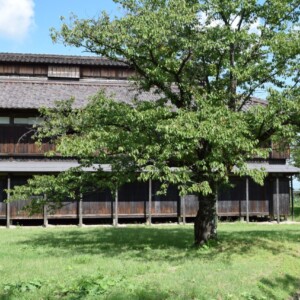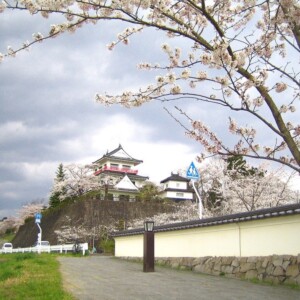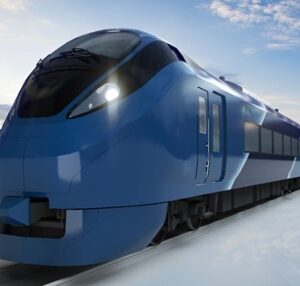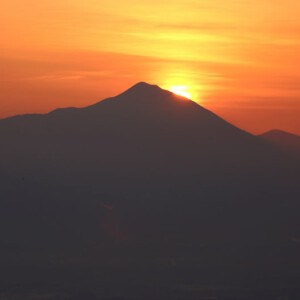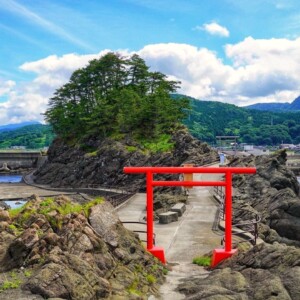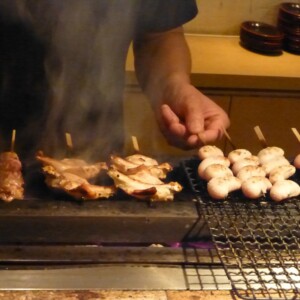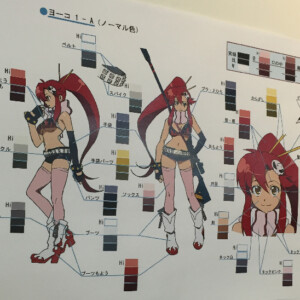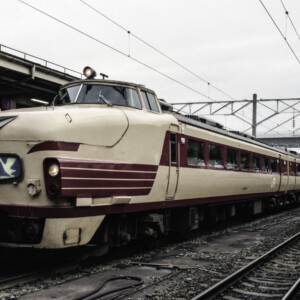
An express train that ran under overhead wires despite being a diesel train (Ou Main Line and Senzan Line)
table of contents
- 1 Ou Main Line
- 2 Express "Zaou" (Ueno Station - Yamagata Station)
- 3 Express "Oga" (operated by diesel railcar between Ueno Station and Akita Station)
- 4 Express "Komakusa" (Yamagata Station - Akita Station, Aomori Station)
- 5 Senzan line
- 6 Express "Senzan" (Diesel railcars operated under the overhead wires between Sendai Station and Yamagata Station)
This time, we will introduce
express trains that ran on the Ou Main Line and Senzan which were operated by diesel railcars even though the entire section from the starting station to the terminal station was electrified However, there are many cases where diesel railcars were used for special trains, and it is difficult to research them all, so we will mainly introduce regular trains.
Additionally, cases where only some of the trains with multiple starting and ending stations run under overhead wires for the entire section are excluded.
(On this route, the express " Senshu " is excluded.
In addition to the "Senshu" train that connects Sendai Station and Aomori Station, there is also a train that connects Yonezawa Station and Aomori Station
for information on what "dietic cars" and "electrification" are, as we have explained in Tohoku Main Line Edition
The previous article, " Joban Line Edition ," can be found here.
Ou Main Line
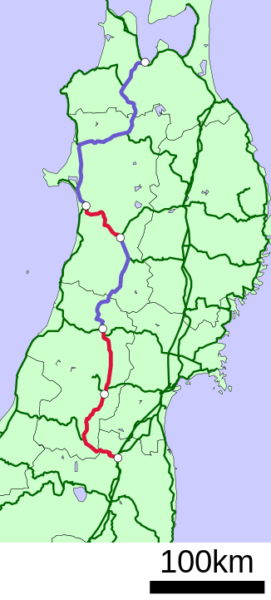
Author: Lincun from Japanese Wikipedia, CC Attribution-ShareAlike 3.0
, https://commons.wikimedia.org/w/index.php?curid=4901440
The Ou Main Line runs from Fukushima Station Station, Yamagata Station , and Shinjo Station in Yamagata Prefecture, Yokote Station, Omagari Station, Akita Station, Higashi-Noshiro Station, and Odate Station in Akita Prefecture, Aomori Prefecture.
Because the roles played by the line between Fukushima Station and Akita Station and between Akita Station and Aomori Station are slightly different, this article will focus on
trains that ran through the former section between Fukushima Station and Akita Station (trains that ran through the latter section but did not enter the former section will be covered in a future article).
Until the Tohoku Shinkansen opened in 1982, the Ou Main Line played
a role in connecting the Tokyo metropolitan area and Fukushima Prefecture with the three prefectures of Yamagata, Akita, and Aomori With the opening of the Tohoku Shinkansen and the subsequent opening of the Yamagata Shinkansen and Akita Shinkansen, the line's role as one of the main routes connecting the Tokyo metropolitan area and the Tohoku region has declined.
However, some sections are now the routes of the Yamagata Shinkansen's "Tsubasa" and the Akita Shinkansen's "Komachi," so it remains important to this day.
Note that the names Yamagata Shinkansen and Akita Shinkansen are not official line names, and the sections these trains pass through (between Fukushima Station and Shinjo Station, and between Omagari Station and Akita Station) remain officially called the Ou Main Line.
The Ou Main Line was first electrified with DC power between Fukushima Station and Yonezawa Station in April 1949.
Next, in November 1960, the section between Yamagata Station and Uzen-Chitose Station was electrified with DC power.
In September 1968, the sections that were already DC-electrified were converted to AC power, and the section between Yonezawa Station and Yamagata Station was also electrified with AC power.
In August 1971, the section between Akita Station and Aomori Station was electrified with AC power. Finally
, October 1975 the section between Uzen-Chitose Station and Akita Station was electrified with AC power, completing the electrification of the entire line
We will not go into detailed explanations about DC and AC, but since the types of power sources used to run trains are different in DC and AC electrified sections, trains that are only compatible with one electrification method cannot run directly between both electrified sections.
Following damage to the Ou Main Line caused by heavy rains in July 2024, train service resumed in April 2025 with the electrification equipment removed from the section from Shinjo Station to Innai Station in Akita Prefecture. As
a result , the Ou Main Line is no longer electrified throughout its entire length .
The reason behind the decision to remove the electrification equipment is that, as mentioned earlier, the Ou Main Line is no longer the main route connecting the Tokyo metropolitan area and the Tohoku region.
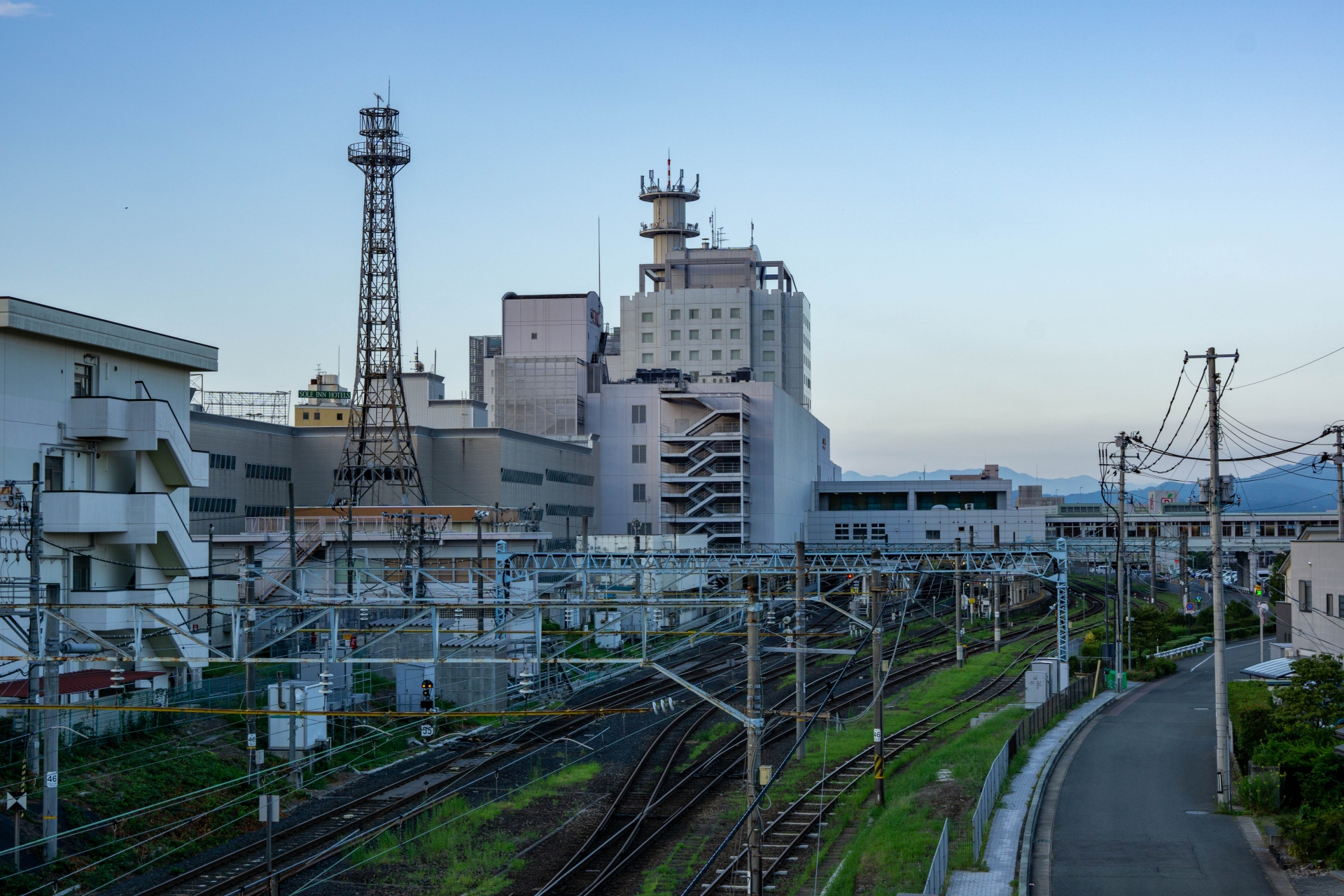
Express "Zaou" (Ueno Station - Yamagata Station)
In June 1960, an express train was launched connecting Ueno Station in Tokyo and Yamagata Station in Yamagata Prefecture via the Tohoku Main Line and Ou Main Line (passing through stations such as Omiya Station in Saitama Prefecture, Utsunomiya Station in Tochigi Prefecture, and Fukushima Station in Fukushima Prefecture), and was given the nickname
Zao The nickname is thought to come from the Zao mountain range that towers over the border between Miyagi and Yamagata prefectures.
When the Zao first appeared, it was a traditional train with a locomotive pulling passenger cars.
Between Ueno Station and Fukushima Station, it operated in conjunction with Matsushima
The Matsushima's operating section was between Ueno Station and Sendai Station. It operated
in a similar manner to the later Tohoku Shinkansen Yamabiko (mainly between Tokyo Station and Sendai Station) and the Yamagata Shinkansen Tsubasa (Tokyo Station to Yamagata Station/Shinjo Station), which were connected and operated between Tokyo Station and Fukushima Station.
In October 1963, the name was changed from "Zao" to
Zao " The number of round trips per day was also increased.
The "Zao" train, which used diesel railcars, also appeared, and the timetable for September 1964 showed two round trips per day as regular diesel railcar trains (trains that ran every day) and one round trip as a seasonal passenger train (trains that ran during certain seasons).
The journey time between Ueno Station and Yamagata Station was about 6 hours 10 to 30 minutes for diesel railcar trains, and about 7 hours 30 minutes for passenger car trains.
Between Ueno Station and Koriyama Station in Fukushima Prefecture, the train was coupled with express trains such as Iide " and " Bandai
In the timetable for the following month, October 1964, there was one round trip of regular diesel railcar trains and one round trip of regular passenger car trains per day, and to replace the reduced number of diesel railcar trains, the diesel railcar express train " Yamabato " was created, running between the same Ueno Station and Yamagata Station.
In 1968, electrification was completed between Fukushima Station and Yamagata Station, and in the October timetable revision, some Zao services were switched
to 455 series electric railcars This reduced the travel time between Ueno Station and Yamagata Station for Zao trains to around five hours.
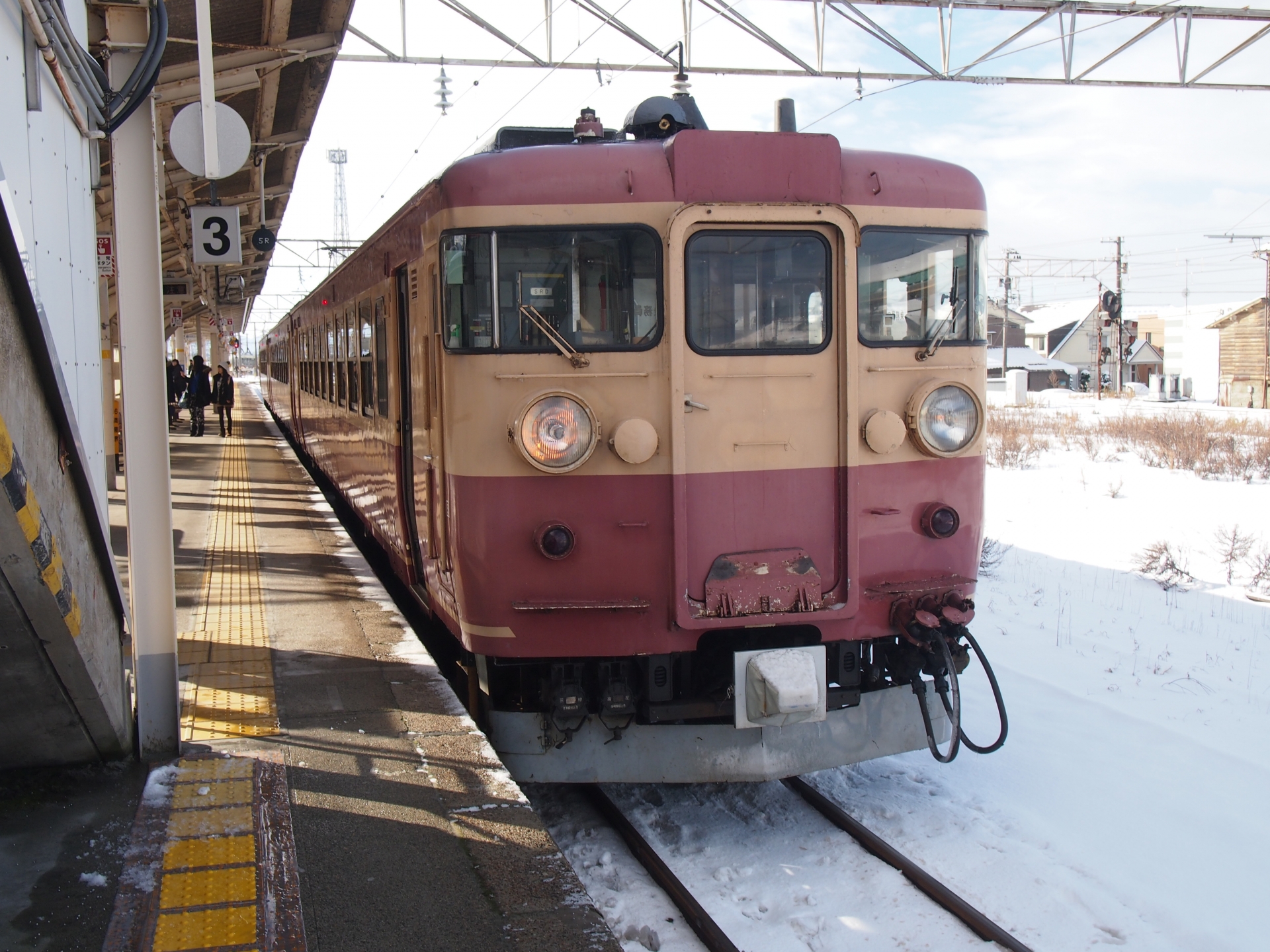
The system consists of two round trips of electric trains and one round trip of diesel railcars.
The diesel railcars will be diesel express trains that run under the overhead wires
The reason why the diesel railcar "Zaou" remained is because
it was coupled with the diesel express "Iide" There are a few examples of diesel railcars and electric trains being coupled together and operated, but it is not common practice.
Even if the operating section was entirely electrified, trains that were operated in conjunction with diesel railcars had to be operated by diesel railcars.
The "Iide" was a train that ran between Ueno Station and Niigata Station via the Tohoku Main Line, Ban'etsu West Line, and Shin'etsu Main Line.
The section of the Ban'etsu West Line between Kitakata Station in Fukushima Prefecture and Niitsu Station in Niigata Prefecture was not electrified, so it was impossible to turn the "Iide" into an electric train
(as of 2025, the electrified section of the Ban'etsu West Line has been shortened to between Koriyama Station and Aizuwakamatsu Station).
With the timetable revision in March 1972 regular Zao service was discontinued , and all trains became seasonal or special service that only operated during peak passenger periods.
The main reason for the reduction in Zao service was that the Zao was upgraded to the limited express Yamabato, which runs on the same route.
After that, there was no major change for a while, but with the opening of the Tohoku Shinkansen in June 1982, a timetable revision was implemented on November 15th, and one round trip of the Zao regular train was introduced per day. It is
notable that during this period, the Zao was coupled with the Matsushima, which it had previously been coupled with, between Ueno Station and Fukushima Station.
In addition, one round trip of the seasonal Zao was introduced between Fukushima Station and Yamagata Station.
the diesel railcar "Zaou" was discontinued with
the timetable revision in November 1982. The "Iide" railcar, which was coupled to the diesel railcar "Zaou", was also discontinued.
In March 1985, the regular Zao service was discontinued again, and only special trains were operated.
The service area was between Ueno Station and Yamagata Station, or between Ueno Station and Shinjo Station.
Furthermore, all of the special Zao trains listed in the timetable for that month were passenger trains.
The Zao special express train was discontinued in August 1991 to allow construction work to be carried out on the Ou Main Line to allow the Yamagata Shinkansen Tsubasa to run on it.
However, in November, Zao was reinstated as the name of a rapid train running between Fukushima Station and Yamagata Station.
The rapid Zao train was in service until around 1999.
Currently, there are no rapid trains running between Fukushima Station and Yamagata Station.
Express "Oga" (operated by diesel railcar between Ueno Station and Akita Station)
In October 1961, the night train that ran between Ueno Station in Tokyo and Akita Station in Akita Prefecture via the Tohoku Main Line and Ou Main Line (passing through stations such as Omiya, Utsunomiya, Fukushima, and Yamagata) was upgraded to
Oga The nickname likely comes from the Oga Peninsula in Akita Prefecture.
Two years later, in October 1963, it was renamed Oga
Until 1968, the Oga was an overnight train with a locomotive pulling passenger cars, but a major change came in October 1968. An express
train using diesel railcars , running one round trip per day (a train that does not run overnight).
Fukushima Station in conjunction with the Hakkoda express train, which runs between Ueno Station and Aomori Station on the Tohoku Main Line .
The daytime diesel train "Oga" took over 10 hours to travel from Ueno Station to Akita Station.
In an age where there are night trains and the limited express "Tsubasa" that run the same route, I wonder if there were people who would use the daytime "Oga" for the entire route.
, which is the route of the Oga completed in October 1975 , so trains operated by diesel railcars should have been able to be converted to electric railcars after that.
However, since the trains continued to be operated by diesel railcars even after electrification was completed, the entire route became an overhead line diesel express train.
The reason why the "Oga" could not be replaced by electric trains is thought to be because
the electrification method would change along the way The Tohoku Main Line on which the "Oga" runs is divided by Kuroiso Station in Tochigi Prefecture, and the power source for electric trains on the south side is 1,500V DC, while on the north side it is 20,000V AC
(the current boundary has moved from the Kuroiso Station premises to the north side of the station).
In order to run across both electrification methods, electric trains that are compatible with both are required.
On the other hand, diesel railcars can run directly regardless of the electrification method.
That being said, the Zao, which I mentioned earlier, also runs on the Tohoku Main Line, but it has been replaced with the 455 series electric train, which is an AC/DC dual-mode electric train (except for trains coupled with the Iide).
So why did the Oga, which is not coupled with other diesel trains, remain a diesel train? Perhaps it was because AC/DC dual-mode electric trains were expensive, and there was probably a shortage of cars. I think
there were circumstances such as that, even if they could convert the Zao to an electric train, they could not afford to fund the electric trains used by the Oga.
With the opening of the Tohoku Shinkansen and Joetsu Shinkansen in 1982, a large-scale reorganization of express and rapid trains running on conventional lines in the Tohoku region was carried out.
The daytime diesel express "Oga" was discontinued with
the timetable revision on November 15, 1982. It had only been in operation for a short period of 14 years since its introduction in 1968, and continued to be operated by diesel railcars until its discontinuation.
The Oga now operates only one round-trip seasonal night train with passenger cars.
The remaining Oga passenger train was changed to a special train that only operated during peak passenger seasons in 1985, and finally ceased operation altogether around the beginning of 1995.
For more information on "Oga", please see the article below.
Express "Komakusa" (Yamagata Station - Akita Station, Aomori Station)
The express " Komakusa " was introduced in the timetable revision of October 1970.
It runs between Yamagata Station and Akita Station, and takes about four hours.
From the beginning, it was operated by diesel railcars.
Dicentra an alpine plant that grows wild in the Zao mountain range and other areas .
Electrification of the Komakusa's operating route was completed in October 1975 , but it continued to operate using diesel railcars, so the entire route became an overhead line diesel express service.
In October 1978, the operating section was changed to Yamagata Station to Aomori Station.
Since electrification of the Ou Main Line from Akita Station to Aomori Station was completed in August 1971, the Komakusa continues to operate as an overhead line diesel express train the entire route.
The journey time for the outbound train from Yamagata to Aomori is 6 hours 42 minutes, while the journey time for the inbound train is 7 hours 41 minutes, a difference of 59 minutes .
At Aomori Station, there is a
transfer schedule for the Seikan Ferry, which connects Aomori For more information about the Seikan Ferry, please see the article below.
why "Komakusa" remained a diesel railcar is thought to be because
the train it was coupled to was also a diesel railcar Downbound trains from Yamagata to Aomori were coupled with
Gassan 1 Gassan 1 ran from Shinjo Station via the Rikuu West Line, and from Amarume Station traveled south on the Uetsu Main Line to Nezugaseki Station on the Sea of Japan side of Yamagata Prefecture. The
Rikuu West Line is not electrified, so "Gassan" could not be converted into an electric train.
By the way, Gassan 1 was coupled with
Uetsu 2 This Uetsu was also an overhead rail diesel express train for the entire section, so I plan to cover it in a later article.
The downbound train from Aomori to Yamagata was coupled with
Tazawa No. 4 Also, from Shinjo Station to Yamagata Station, it was coupled with the "Gassan No. 6" bound for Yamagata from Nezumigaseki.
"Tazawa No. 4" departed from Akita Station, and from Omagari Station it traveled via the Tazawako Line, then south on the Tohoku Main Line from Morioka Station to Sendai Station.
The Tazawako Line was not electrified at the time, so it was not possible to convert the "Tazawa" into an electric train.
However, the Tazawako Line was electrified in 1982, and is now also the route of the Akita Shinkansen "Komachi.
" The "Tazawa" can be seen as a predecessor to the "Komachi."
With the timetable revision on November 15, 1982 , the Komakusa was abolished and absorbed into the Ou Main Line's limited express Tsubasa.
Until the end, it operated with only one round trip per day using diesel railcars.
Please take a look at the article below for an explanation of the Tsubasa limited express before the opening of the Yamagata Shinkansen.
In July 1992, about 10 years after the discontinuation of the express "Komakusa," the Yamagata Shinkansen "Tsubasa" began operating between Tokyo Station and Yamagata Station.
limited express "Komakusa" service was launched,
running to Shinjo Station or Akita Station However, ahead of the December 1999 extension of the Yamagata Shinkansen to Shinjo Station, in March 1999 the limited express "Komakusa" was reassigned to operate north of Shinjo Station and was converted into a rapid train.
In December 2002, the rapid "Komakusa" service was discontinued.
Currently, the only express trains operating between Shinjo Station and Akita Station are two down trains from Shinjo to Yokobori, one up train from Yokobori to Shinjo, and one down train from Yuzawa to Akita.
Senzan line
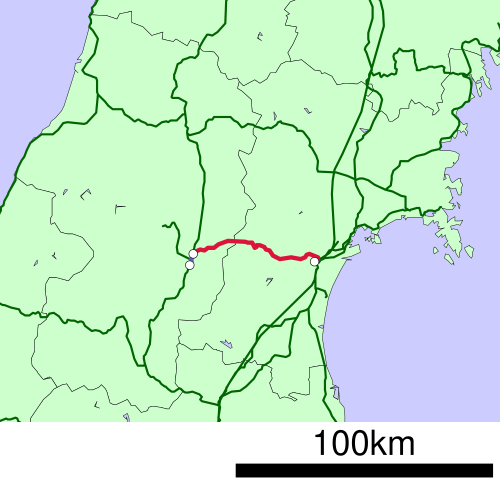
Lincun – Map: Own work. Data used: Ministry of Land, Infrastructure, Transport and Tourism National Land Numerical Information (Administrative Area (N03), Railway (N02), Lake (W09)), CC BY-SA 3.0
, https://commons.wikimedia.org/w/index.php?curid=97569553
The Senzan Line is a line that connects
Sendai Station Uzen-Chitose Station in Yamagata City However, there are no trains that start or end at Uzen-Chitose Station, and trains enter the Ou Main Line and go directly to Yamagata Station.
In effect, a line that connects Sendai Station and Yamagata Station .
Currently, the Senzan Line mainly serves as a commuter and student transport service for the Sendai metropolitan area.
Although it also plays a role in connecting Sendai City and Yamagata City, express buses seem to be more popular.
However, in the past, it also played a role in connecting Sendai and Niigata via routes such as the Senzan Line, Ou Main Line, and Yonesaka Line (passing through stations such as Yamagata, Yonezawa, and Sakamachi in Niigata Prefecture).
The Senzan Line was first electrified with DC between Sakunami Station and Yamadera Station in November 1937.
Then, in August 1955, the section between Rikuzen-Ochiai Station and Kumagane Station was electrified with AC, the first electrification on a Japanese railway , leaving the Senzan Line with a mixture of DC and AC electrification.
In September 1957, the section between Sendai Station and Rikuzen-Ochiai Station and the section between Kumagane Station and Sakunami Station were electrified with AC.
The Sakunami Station premises marked the boundary between DC and AC electrification.
In November 1960, the section between Yamadera Station and Uzen-Chitose Station was electrified with DC current.
At the same time, the section between Yamagata Station and Uzen-Chitose Station on the Ou Main Line was also electrified with DC current, so the section from Sendai Station to Yamagata Station was now electrified.
In addition, in November 1968, the DC electrified sections were changed to AC electrification, and the entire Senzan Line became an AC electrified line, which remains the case to this day.
Although the Senzan Line was initially electrified with DC, it was later converted to AC because it was chosen as a testing ground for the practical application of AC electrification .
Using the data and technology gained from the tests on the Senzan Line, main lines in the Tohoku, Hokuriku, and Kyushu regions were subsequently electrified with AC. Furthermore
, sections of the Senzan Line and the Ou Main Line that had already been electrified with DC were converted to AC electrification, in line with the electrification method used on surrounding lines.
All Shinkansen lines, including the Tokaido Shinkansen, which opened in 1964, are electrified with alternating current, without exception.
The results of the tests on the Senzan Line led to the birth of the Shinkansen .
Express "Senzan" (Diesel railcars operated under the overhead wires between Sendai Station and Yamagata Station)
The " Senzan " began operating between Sendai Station and Yamagata Station/Kaminoyama Station (now Kaminoyama Onsen Station) via the Senzan Line and Ou Main Line with the timetable revision in October 1963.
it was initially a semi-express train
The Senzan Line and the Ou Main Line between Yamagata Station and Uzen-Chitose Station were already electrified.
Therefore, the "Senzan" service between Sendai Station and Yamagata Station, which ran two round trips a day, was
originally an overhead diesel semi-express train the entire length Furthermore, the non-electrified section of the train between Sendai Station and Kaminoyama Station, which ran one round trip a day, was only 12.1 km from Yamagata Station to Kaminoyama Station.
In October 1968, the "Senzan" was upgraded to an express train ,
and all three round trips per day ran between Sendai Station and Yamagata Station.
Additionally, trains No. 1 and No. 2 on both the up and down routes have been replaced with electric trains.
No. 3 continues to operate as a diesel railcar, although the entire section is electrified .
We speculate that the reason it remained a diesel railcar was either because there were not enough electric trains, or because the diesel railcars used for No. 3 were being reused for other diesel trains.
The travel time between Sendai Station and Yamagata Station was about 1 hour 10 minutes by electric train and about 1 hour 40 minutes by diesel railcar, quite a difference.
In October 1978, ten years after it was upgraded to an express service, the remaining round trip using diesel railcars was converted to an electric train , bringing to an end the service's 15-year history as an express service using diesel railcars on all routes under overhead lines, which had continued since 1963.
With the timetable revision on November 15, 1982, the Senzan was downgraded to a rapid train, ending its history as an express train.
In March 1985, all regular trains running on the Senzan Line, including local trains, were converted to electric trains, and there is no longer any trace of the old diesel railcars and passenger trains that once ran on the line.
The rapid "Senzan" name continued for a while, but was abolished in 2004.
However, rapid trains on the Senzan Line are still in operation as of 2025.


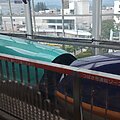
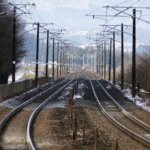
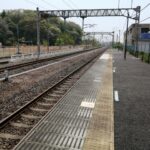





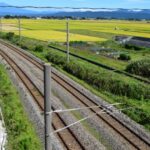
![For some reason, do they have a lot of unusual names? Station names on the Ou Main Line [Fukushima, Yamagata, Akita] 27651763_L](https://jp.neft.asia/wp-content/uploads/2024/05/27651763_l-150x150.jpg)
!["Train" can no longer run! ? What is "non-electrification" on the Ou Main Line? [Akita/Yamagata] 1620px-jr_east_innai_station_platform, _akita_preff](https://jp.neft.asia/wp-content/uploads/2024/12/1620px-JR_East_Innai_Station_Platform_Akita_Pref-150x150.jpg)



![[JR East Pass Trip: Day 3] A day trip to Aomori Bullet Tour to foster your energy at home! Tsugaru Kokeshi at Shin-Aomori Station](https://jp.neft.asia/wp-content/uploads/2022/12/IMG_3878-1200x675-1-150x150.jpg)
![It's so big that the main castle is hazy and you can't see! Yamagata Castle, known as Kasumi Castle [Yamagata Prefecture] Yamagata Castle's main castle, Ichimonji gate](https://jp.neft.asia/wp-content/uploads/2023/08/3261071_m-150x150.jpg)

